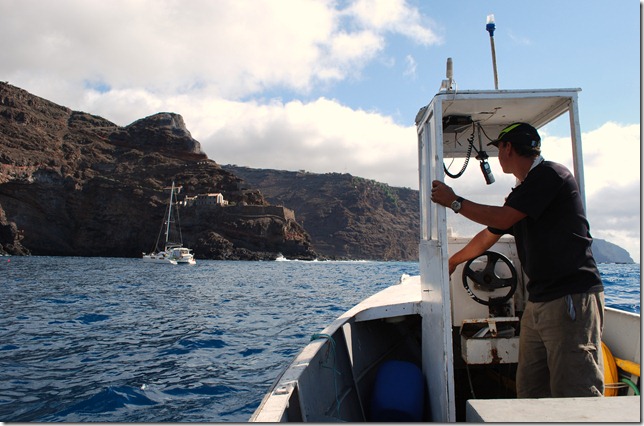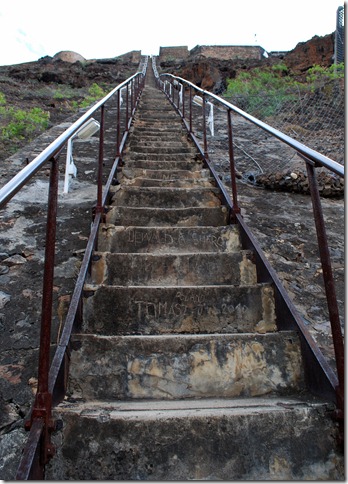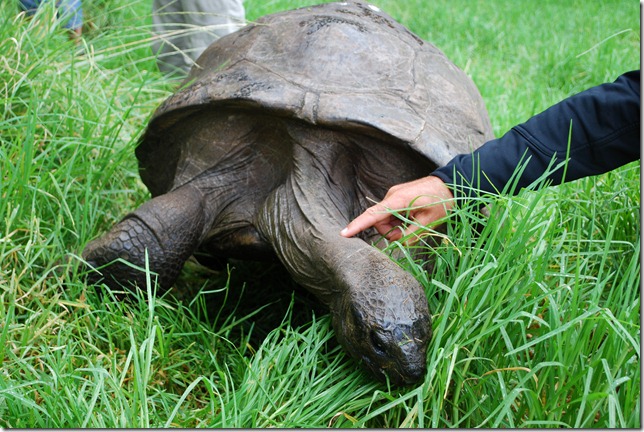As the sun rose on Wednesday morning, Dallas could easily make out a large mass of volcanic rock in the distance. I had the 12-3 a.m. watch, so by the time I arose, I could see the details of the east face of St. Helena Island. We rounded the north end and arrived at the anchorage on the northwest corner just in time for the rain. We threw on our jackets and went on deck to try to attach to a mooring that turned out to be a buoy on a shoestring. That wasn’t quite adequate to hold our 26,000-pound boat, so we tossed it off and took a little tour around the mooring field before settling on a place to anchor in 50’ of water atop a sandy bottom.
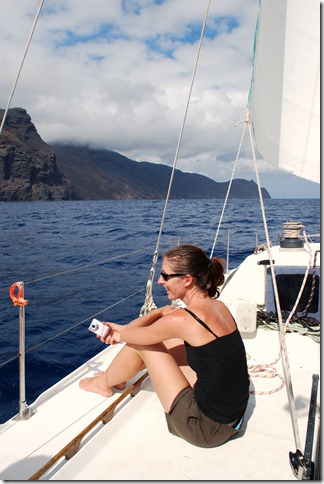 Tracey was in good spirits at the end of a very pleasant passage
Tracey was in good spirits at the end of a very pleasant passage
We were excited to see that our French friends from S/V RDJ had already arrived that morning – well, at least I was. Maybe after being away from the U.S. for so long, I’m losing my competitive spirit, but after all, Dallas pointed out since they left Namibia a day before us, technically we were the winners of the “race”. (They weren’t persuaded by this to buy the evening beers, however.)
One of the first thing that we noticed about this anchorage was the intense swell. There is no breakwater (structure to provide protection), so it is not uncommon to see monohulls rocking back and forth at 45 degree angles. Also, there’s no safe place to leave the dinghy, so you must rely on the local ferries to bring you to and from shore and must jump onto the dock from the ferry boat with the assistance of some Tarzan-style ropes hanging there! For the most part, the ferry service has served us well, although it requires some advanced planning since the last ferry leaves at 6:45 p.m. If you want to return to your boat later than that, you have to book a time in advance, so our night out tonight will be time-limited. (Maybe this is for the best since we are leaving tomorrow!)
In addition to RDJ, we reconnected with some other friends from S/V Moose who have been here for a week already. Unfortunately, they will be here for another week waiting on another boat to arrive from Cape Town with their new autopilot. Their old one broke three days out of Cape Town, and they had to steer for 11 days by hand, just the two of them, with very impaired steering control (i.e., having to rotate the wheel 360 degrees just to change course by a few degrees). Needless to say, it was their worst passage ever, but they’ve been traveling with their boat for 11 happy years without such complications.
All of the 3,000 inhabitants of the island live in or near Jamestown which sits next to the anchorage. The inhabitants are British citizens, but most have descended from the Chinese and/or Indian laborers that were brought in as laborers and thus have dark skin. They are very friendly and interested in us yachties and our travel plans. We learned from Duncan and Irene (from S/V Moose) that one of the friendly locals was a popular and capable tour guide, so we booked our tour for Friday.
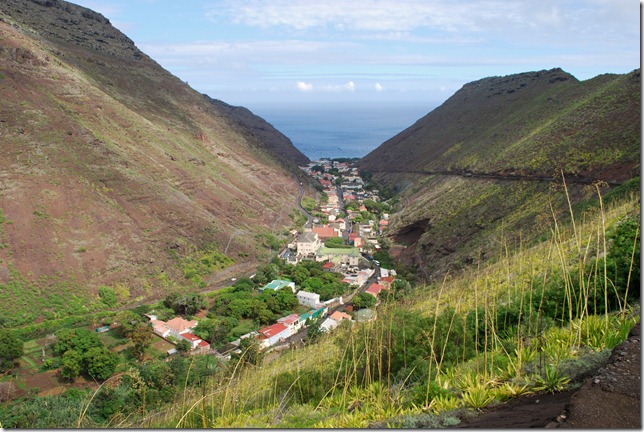 Jamestown is nestled in the valley
Jamestown is nestled in the valley
The island itself has an interesting history. It has been involved in several conflicts, as indicated by the ruins of military fortifications and look-out points that can be seen immediately as you arrive in the anchorage, which is the only way to arrive in St. Helena. Apparently, the fortifications didn’t always work out — for example, a German U-Boat shot down a British warship in the anchorage during World War II. However, the British did manage to keep Napoleon Bonaparte secure in exile here for almost six years until he died from stomach cancer in 1821.
After learning these interesting tidbits, it was time to take care of business online and in the shops and to do some exploring of our own. Tracey and I hiked around one of the old military fortifications that overlooked the anchorage on Thursday morning, then went for broke and climbed Jacob’s Ladder that afternoon. The Ladder consists of 700 steep steps to the top of the mountain where another old fortification is located. Both trips provided nice views, and we both snapped photos incessantly (as we both tend to do).
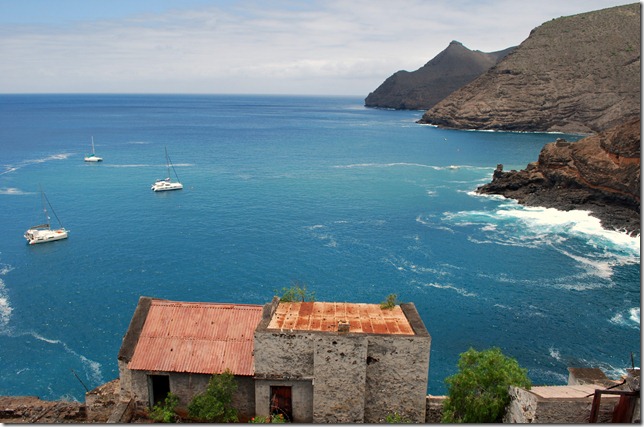 Pura Vida dwarfed by some large charter boats being delivered from South Africa to Europe
Pura Vida dwarfed by some large charter boats being delivered from South Africa to Europe
The record for climbing the Ladder is 5 minutes
Today we met up with the guys from RDJ along with our local guide, Robert, for a trip around the island in the back of his pick-up truck. Unfortunately the weather didn’t totally cooperate with us, but we were able to get a feel for the place and its history. There is an abundance of different kinds of foliage here, from flax (which used to be their main industry until a cotton company moved in), to ferns, to cacti, to over a million of gum-trees that they have planted in the wetlands in an attempt to return it to its former state. In addition to these vistas, we were shown Napoleon’s home and gardens, his tomb (although empty since the French exhumed his body and returned it to France in 1840), and the resident tortoises, one of whom is estimated to be 174 years old!
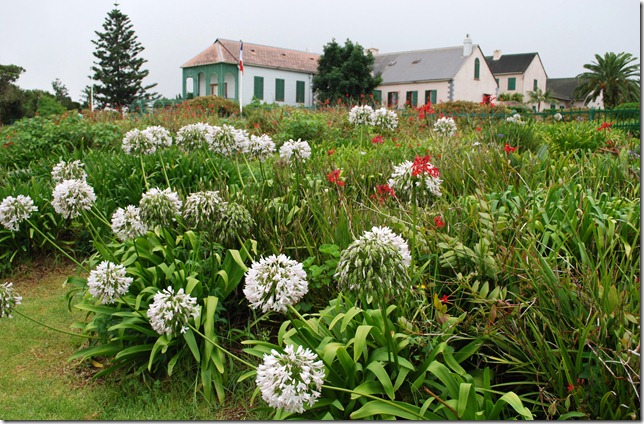 Longwood House was an old and isolated farmhouse restored for the purpose of Napoleon’s exile
Longwood House was an old and isolated farmhouse restored for the purpose of Napoleon’s exile
St. Helena is nice, but after just a few days, I think we can safely say that we’ve been here and done that. This works out well, since we need to get going! We set sail for Recife, Brazil tomorrow and are hoping to average 5 knots so that we can make it there within 15 days…


